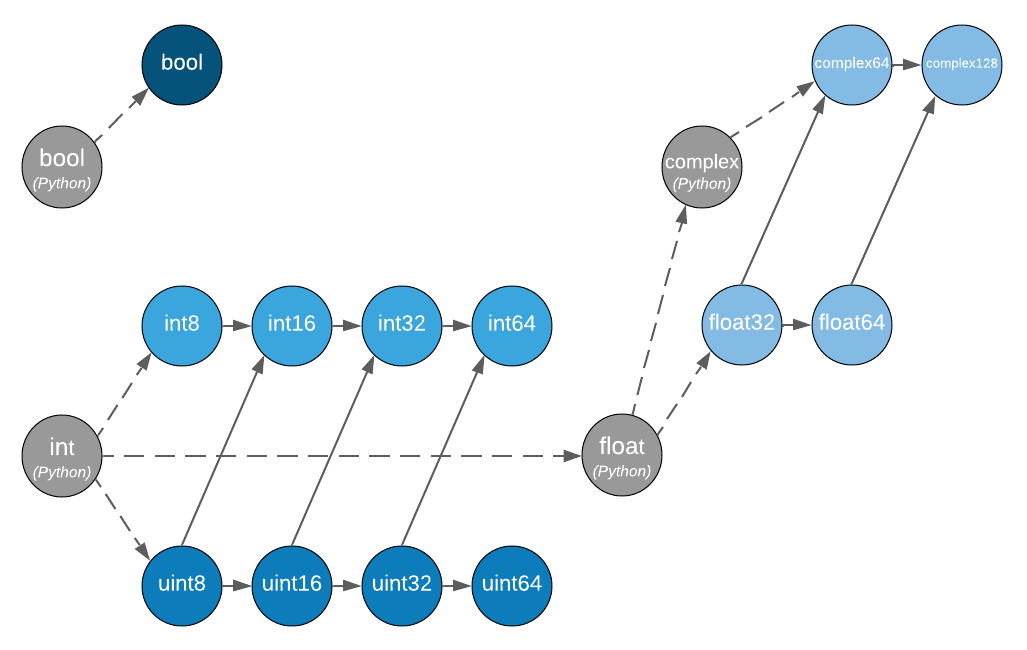Type Promotion Rules¶
Array API specification for type promotion rules.
Type promotion rules can be understood at a high level from the following diagram:

Type promotion diagram. Promotion between any two types is given by their join on this lattice. Only the types of participating arrays matter, not their values. Dashed lines indicate that behavior for Python scalars is undefined on overflow. Boolean, integer and floating-point dtypes are not connected, indicating mixed-kind promotion is undefined.
Rules¶
A conforming implementation of the array API standard must implement the following type promotion rules governing the common result type for two array operands during an arithmetic operation.
A conforming implementation of the array API standard may support additional type promotion rules beyond those described in this specification.
Note
Type codes are used here to keep tables readable; they are not part of the standard. In code, use the data type objects specified in Data Types (e.g., int16 rather than 'i2').
The following type promotion tables specify the casting behavior for operations involving two array operands. When more than two array operands participate, application of the promotion tables is associative (i.e., the result does not depend on operand order).
Signed integer type promotion table¶
i1 |
i2 |
i4 |
i8 |
|
|---|---|---|---|---|
i1 |
i1 |
i2 |
i4 |
i8 |
i2 |
i2 |
i2 |
i4 |
i8 |
i4 |
i4 |
i4 |
i4 |
i8 |
i8 |
i8 |
i8 |
i8 |
i8 |
where
i1: 8-bit signed integer (i.e.,
int8)i2: 16-bit signed integer (i.e.,
int16)i4: 32-bit signed integer (i.e.,
int32)i8: 64-bit signed integer (i.e.,
int64)
Unsigned integer type promotion table¶
u1 |
u2 |
u4 |
u8 |
|
|---|---|---|---|---|
u1 |
u1 |
u2 |
u4 |
u8 |
u2 |
u2 |
u2 |
u4 |
u8 |
u4 |
u4 |
u4 |
u4 |
u8 |
u8 |
u8 |
u8 |
u8 |
u8 |
where
u1: 8-bit unsigned integer (i.e.,
uint8)u2: 16-bit unsigned integer (i.e.,
uint16)u4: 32-bit unsigned integer (i.e.,
uint32)u8: 64-bit unsigned integer (i.e.,
uint64)
Mixed unsigned and signed integer type promotion table¶
u1 |
u2 |
u4 |
|
|---|---|---|---|
i1 |
i2 |
i4 |
i8 |
i2 |
i2 |
i4 |
i8 |
i4 |
i4 |
i4 |
i8 |
i8 |
i8 |
i8 |
i8 |
Floating-point type promotion table¶
f4 |
f8 |
c8 |
c16 |
|
|---|---|---|---|---|
f4 |
f4 |
f8 |
c8 |
c16 |
f8 |
f8 |
f8 |
c16 |
c16 |
c8 |
c8 |
c16 |
c8 |
c16 |
c16 |
c16 |
c16 |
c16 |
c16 |
where
f4: single-precision (32-bit) floating-point number (i.e.,
float32)f8: double-precision (64-bit) floating-point number (i.e.,
float64)c8: single-precision complex floating-point number (i.e.,
complex64) composed of two single-precision (32-bit) floating-point numbersc16: double-precision complex floating-point number (i.e.,
complex128) composed of two double-precision (64-bit) floating-point numbers
Notes¶
Type promotion rules must apply when determining the common result type for two array operands during an arithmetic operation, regardless of array dimension. Accordingly, zero-dimensional arrays must be subject to the same type promotion rules as dimensional arrays.
Type promotion of non-numerical data types to numerical data types is unspecified (e.g.,
booltointxxorfloatxx).
Note
Mixed integer and floating-point type promotion rules are not specified because behavior varies between implementations.
Mixing arrays with Python scalars¶
Using Python scalars (i.e., instances of bool, int, float, complex) together with arrays must be supported for:
array <op> scalarscalar <op> array
where <op> is a built-in operator (including in-place operators, but excluding the matmul @ operator; see Operators for operators supported by the array object) and scalar has a type and value compatible with the array data type:
a Python
boolfor aboolarray data type.a Python
intwithin the bounds of the given data type for integer array Data Types.a Python
intorfloatfor real-valued floating-point array data types.a Python
int,float, orcomplexfor complex floating-point array data types.
Provided the above requirements are met, the expected behavior is equivalent to:
Convert the scalar to zero-dimensional array with the same data type as that of the array used in the expression.
Execute the operation for
array <op> 0-D array(or0-D array <op> arrayifscalarwas the left-hand argument).
Note
Behavior is not specified when mixing a Python float and an array with an integer data type; this may give float32, float64, or raise an exception. Behavior is implementation-specific.
Similarly, behavior is not specified when mixing a Python complex and an array with a real-valued data type; this may give complex64, complex128, or raise an exception. Behavior is implementation-specific.
Behavior is also not specified for integers outside of the bounds of a given integer data type. Integers outside of bounds may result in overflow or an error.